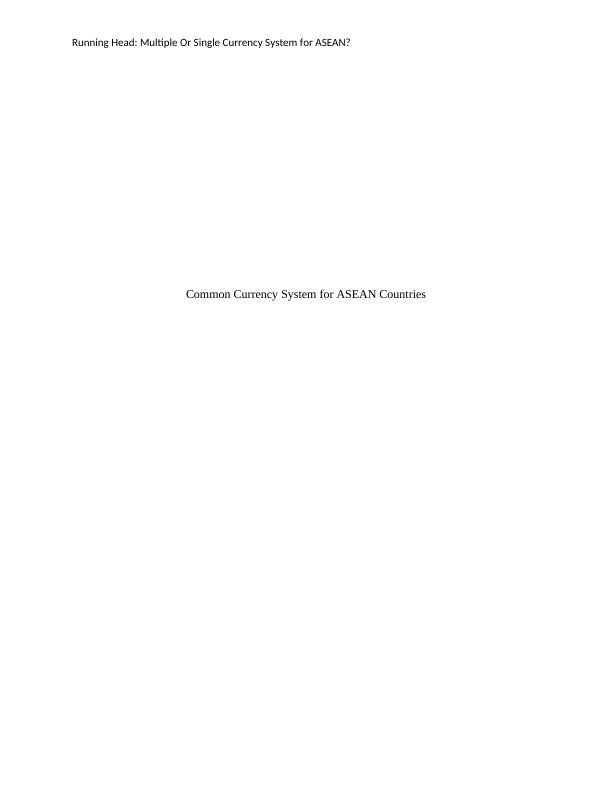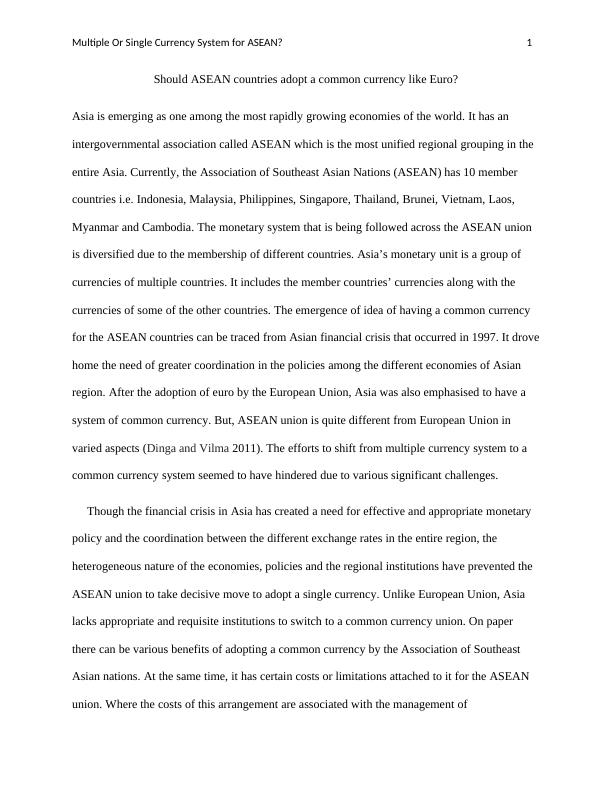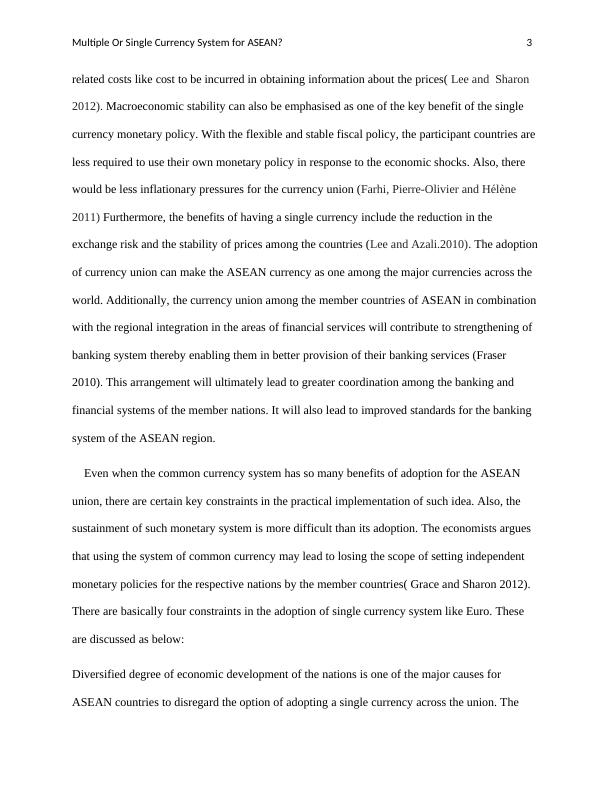Multiple Or Single Currency System for ASEAN Report
Added on 2020-03-16
11 Pages3116 Words177 Views
Running Head: Multiple Or Single Currency System for ASEAN?Common Currency System for ASEAN Countries

Multiple Or Single Currency System for ASEAN? 1Should ASEAN countries adopt a common currency like Euro?Asia is emerging as one among the most rapidly growing economies of the world. It has an intergovernmental association called ASEAN which is the most unified regional grouping in the entire Asia. Currently, the Association of Southeast Asian Nations (ASEAN) has 10 member countries i.e. Indonesia, Malaysia, Philippines, Singapore, Thailand, Brunei, Vietnam, Laos, Myanmar and Cambodia. The monetary system that is being followed across the ASEAN union is diversified due to the membership of different countries. Asia’s monetary unit is a group of currencies of multiple countries. It includes the member countries’ currencies along with the currencies of some of the other countries. The emergence of idea of having a common currency for the ASEAN countries can be traced from Asian financial crisis that occurred in 1997. It drovehome the need of greater coordination in the policies among the different economies of Asian region. After the adoption of euro by the European Union, Asia was also emphasised to have a system of common currency. But, ASEAN union is quite different from European Union in varied aspects (Dinga and Vilma 2011). The efforts to shift from multiple currency system to a common currency system seemed to have hindered due to various significant challenges. Though the financial crisis in Asia has created a need for effective and appropriate monetary policy and the coordination between the different exchange rates in the entire region, the heterogeneous nature of the economies, policies and the regional institutions have prevented the ASEAN union to take decisive move to adopt a single currency. Unlike European Union, Asia lacks appropriate and requisite institutions to switch to a common currency union. On paper there can be various benefits of adopting a common currency by the Association of Southeast Asian nations. At the same time, it has certain costs or limitations attached to it for the ASEAN union. Where the costs of this arrangement are associated with the management of

Multiple Or Single Currency System for ASEAN? 2macroeconomic level, benefits are often associated with the microeconomic level because of the transformation of diversified currency system into the common currency is expected to offer gainin the economic efficiency. The adoption of a single currency for the entire ASEAN union will contribute to the greater macroeconomic stability for those participant countries that have a mixed track record in the areaof implementation of monetary policy for their nation before joining the common currency union(Murray and Moxon‐Browne 2013). The another benefit of adopting the common currency which has been realised is that it would facilitate the seamless trade of goods, services and investments as well, among the member countries of the ASEAN union, leading to increased revenue generation for both the countries. As the use of common currency will help in reduction of transactions costs of conducting the cross border business and it will also remove the volatilityof exchange rates nationwide (Gharleghi, Najla and Benjamin 2015). The implementation of common currency policy could be seen for the countries that have an uneven record of inflationary control and patchy exchange rate management as they will be benefited by the monetary policy formulated by the regional central bank which is more credible. Further, it is an established fact that if the extent of intra-regional trade is large, there will be the more economic benefits of having a common currency for a region. Single currency could avoid the trade disruptions due to fluctuating bilateral foreign exchange rates between the potential participant countries in the common currency. Therefore, it can be said that common currency promotes the predictability and lessens the uncertainty. A currency of the country is like its language. As a unique currency promotes effective communication in between the people, a common currency will facilitate effective trade and investments between the member countries of ASEAN union. In the environment of multiple currencies there would be higher transaction costs and other

Multiple Or Single Currency System for ASEAN? 3related costs like cost to be incurred in obtaining information about the prices( Lee and Sharon 2012). Macroeconomic stability can also be emphasised as one of the key benefit of the single currency monetary policy. With the flexible and stable fiscal policy, the participant countries are less required to use their own monetary policy in response to the economic shocks. Also, there would be less inflationary pressures for the currency union (Farhi, Pierre-Olivier and Hélène 2011) Furthermore, the benefits of having a single currency include the reduction in the exchange risk and the stability of prices among the countries (Lee and Azali.2010). The adoptionof currency union can make the ASEAN currency as one among the major currencies across the world. Additionally, the currency union among the member countries of ASEAN in combination with the regional integration in the areas of financial services will contribute to strengthening of banking system thereby enabling them in better provision of their banking services (Fraser 2010). This arrangement will ultimately lead to greater coordination among the banking and financial systems of the member nations. It will also lead to improved standards for the banking system of the ASEAN region. Even when the common currency system has so many benefits of adoption for the ASEAN union, there are certain key constraints in the practical implementation of such idea. Also, the sustainment of such monetary system is more difficult than its adoption. The economists argues that using the system of common currency may lead to losing the scope of setting independent monetary policies for the respective nations by the member countries( Grace and Sharon 2012). There are basically four constraints in the adoption of single currency system like Euro. These are discussed as below:Diversified degree of economic development of the nations is one of the major causes for ASEAN countries to disregard the option of adopting a single currency across the union. The

End of preview
Want to access all the pages? Upload your documents or become a member.
Related Documents
Benefits and Challenges of Common Currency Adoption for ASEAN Countrieslg...
|9
|2760
|80
Report on Common Currency for ASEAN Countrieslg...
|15
|2554
|139
Should ASEAN countries adopt common currency?lg...
|10
|2761
|347
International Financial Markets Institutionslg...
|10
|2720
|63
Association of Southeast Asian Nations (ASEAN)lg...
|9
|1774
|15
Report on the International Financelg...
|9
|2465
|75
